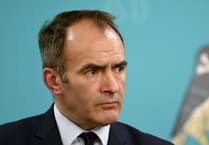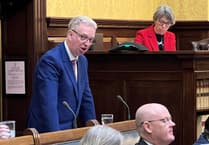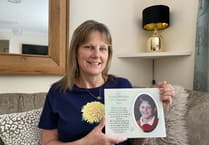The month of June is marked the world over as Pride month, a period dedicated to the celebration and commemoration of lesbian, gay, bisexual, transgender and queer (LGBTQ+) pride. What went into organising the first public Pride event here on the Isle of Man? Siobhan Fletcher looks at the queer history of our island in the third of a five-part series.
Last time, we went back to the early 90s, when Tynwald passed a law decriminalising homosexuality in the Isle of Man.
This time, we’re jumping forward a few decades – to investigate what went into organising the first public Pride held here at home.
But first, let’s set the scene: In 1992, Tynwald decriminalised homosexuality, but the age of consent was set at 21, as was the case for many years over in the UK.
In 2001, this was lowered to 18 and in 2006 it was lowered again, to 16 – as is the case for heterosexuals.
In 2016, after lengthy debate from both sides of the argument, same-sex marriage was legalised.
And in 2020, then-Chief Minister Howard Quayle issued an ‘unqualified public apology’ in the island’s parliament to gay men convicted of same-sex offences under previous Manx laws.
Addressing the gathered parliamentarians, Mr Quayle said: ‘I stand before you, before this house and before the people of our island to apologise for those laws. For the damage they may have caused and for the lives they ruined. I am sorry for that wrong.
‘Nothing I or we can do can erase any past injustice, but I hope that this apology, together with the new legislation before us, can at least start to heal some of the pain caused by past attitudes and decisions.’
It was described as a ‘great day for the Isle of Man’ by campaigner Alan Shea, whose Tynwald Day protest in 1991 galvanised change for the island.
Two years later, the Sexual Offences and Obscene Publications Act came into effect, which pardoned historical gay sex offences committed prior to 1992, and the then-Chief Constable Gary Roberts also apologised. We’ll look more closely at this, next week.
As we touched on at the beginning of this series, the LGBTQ+ community has always made safe spaces for its members to be free.
And the Isle of Man is no different. Before the pageantry of the two Isle of Pride events, there were other, private Prides, marked out of the public eye.
They were held primarily in back gardens and houses around the Island and were exclusive to the community they served.
Describing these events, Alan Shea said: ‘The man that organised them did really well, because it was a bit dangerous having a Pride in those days on the Island. It was done by invitation only.’
The island’s original drag queen, Vida La Fierce (or Gareth Leece when out of drag) said the idea of a private Pride is ‘beautiful’.
He said: ‘It’s lovely because it’s getting together in a safe place.’
But, he said, having a public Pride is ‘important’.
In 2020, the island saw its first youth Pride event, attended by more than 200 young people.
And in 2021 – delayed due to Covid-19 – the Isle of Man held its first public Pride event at the Villa Marina Gardens in Douglas.
Vida La Fierce was one of the members of the Isle of Pride committee, which organised the celebration.
Speaking to me as Vida, she said: ‘You want one that’s public because the act of the party is a statement and protest in itself. It’s like “here we are, having a fantastic time, everybody is welcome, just don’t bring trouble, come along and have fun”.
‘That’s where the bigger, more public ones, really come into their own, because even if you’ve got some bigoted people who don’t want to come, nobody’s forcing you to come, if you want to miss out on some really good fun and entertainment then fine, that’s on you.
‘The fact that it’s so visible is a protest. It’s saying “here we are, we’re completely normal”, but there’s some bright colours and a lot of fun.’
She added: ‘There are always the predictable thing that you see on social media of “when’s straight Pride?” – well, the other 364 days of the year. But also, be thankful you’ve never needed one.
‘Anyone who can’t see a reason for Pride, is ironically the reason for it.’
The Isle of Pride charity consisted of a wide-ranging mix of people from different professional and personal backgrounds.
They included government ministers Clare Barber and Jane Poole-Wilson.
Praising the group, Mrs Poole-Wilson said: ‘They were both amazing events, but there’s no question that putting an event like that on is a huge undertaking, and so those complimentary skills are really valuable.
‘It required a lot of people doing a lot of different things, but there’s no question that everybody’s different skills that they could bring to the table made a difference.’
When asked how they made the decision to push for a public Pride, Mrs Barber said: ‘There were a number of conversations.
‘Jane had taken the equality role within Tynwald and we’d had conversations about areas we could see there was change needed. I also met up with Gareth [Leece], who’d done some Facebook posts floating the idea, and had some really positive responses. And I met up with Zo Bennett, who I was actually helping on a constituency issue, and we got chatting as an aside about the need for Pride on the Isle of Man, and that year-round conversation of where it felt like there was a gap.
‘So, it felt like there was a real opportune moment to bring those various people together and that’s really where Isle of Pride started.’
The team took inspiration from Pride events held elsewhere, but they say the Manx context was key when putting together the first public Pride, as was properly honouring our history.
As Mrs Poole-Wilson said: ‘Particularly for the Isle of Man and our context, it was important to say, “this is the story and this is how we’ve gotten to today”.
‘We [also] knew we wanted it to be a community event, free and open to everybody, and we wanted to provide an experience that anybody and everybody could enjoy.
‘It was a huge undertaking. On the day, [it was] fabulous. In the run up to the day? You’ve seen swans swimming along and paddling frantically – I think we were just… we were flapping and splashing frantically to get it over the line.’
Mrs Barber agreed: ‘A public, free-to-all Pride was very important to us. We were aware there had been previous Pride events, and it certainly wasn’t our intention to detract from them, that was something that was very much needed at that time, and I think probably went as far as maybe it could at that time, safely and confidently.
‘A huge amount of effort went in from previous organisers, but it was very much the large-scale march with an event that was for the whole family that was what we were trying to achieve, and I certainly think we can look back and reflect and think we absolutely did that.’
This is an extract from the third instalment of several articles looking at the history of Pride.
To hear more, tune into the next episode of ‘A Brief History of…’ on Manx Radio tonight (Tuesday, June 20) at 6pm.

.jpg?width=209&height=140&crop=209:145,smart&quality=75)


